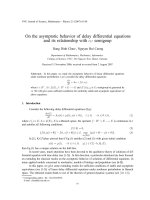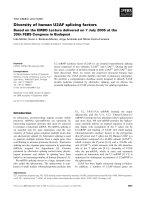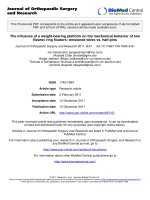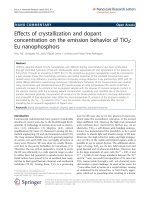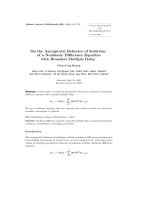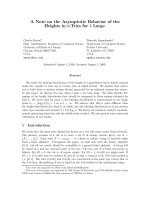Factors affect on the job behavior at thermtrol corporation
Bạn đang xem bản rút gọn của tài liệu. Xem và tải ngay bản đầy đủ của tài liệu tại đây (1.24 MB, 56 trang )
..
RESEARCH PROJECT
(BMBR5103)
FACTORS AFFECTING ON - THE - JOB
BEHAVIOR AT THERMTROL CORPORATION
STUDENT’S FULL NAME
STUDENT ID
INTAKE
ADVISOR’S NAME & TITLE
: HOANG CHI SY
: CGS00018260
: MAY 2014
: NGUYEN THE KHAI (DBA)
August, 2015
ADVISOR’S ASSESSMENT
..............................................................................................................................................
..............................................................................................................................................
..............................................................................................................................................
..............................................................................................................................................
..............................................................................................................................................
..............................................................................................................................................
..............................................................................................................................................
..............................................................................................................................................
..............................................................................................................................................
..............................................................................................................................................
..............................................................................................................................................
..............................................................................................................................................
..............................................................................................................................................
..............................................................................................................................................
..............................................................................................................................................
..............................................................................................................................................
..............................................................................................................................................
ADVISOR’S SIGNATURE
NGUYEN THE KHAI (DBA)
________________________________________________________________
Student: Hoang Chi Sy
Master’s Project
1
ACKNOWLEDGEMENTS
To complete this paper, I have to send my special thanks to Nguyen The Khai, DBA
who has shown our class every step of how to do a research and run SPSS software.
Moreover, he had even personally gone through and give valuable advised on our
paper to every individual in class. Without such detail instructions and advise, we
are unable to complete this paper of Business Research Methods.
I would also like to thanks employees of Thermtrol Coporation, whom had help to
complete the questionnaires which is essential for me to conduct further on the
research.
Lastly, I would like to thanks my family and all friends for supporting me during
my MBA program in order to complete all assignments especially this paper.
________________________________________________________________
Student: Hoang Chi Sy
Master’s Project
2
TABLE OF CONTENTS
ABSTRACT ...................................................................................................... 5
CHAPTER I: INTRODUCTION
1. Thermtrol Corporation Introduction .............................................................. 7
2. Executive Summary ....................................................................................... 7
3. Products and Services .................................................................................... 8
4. Thermtrol Vision ............................................................................................ 9
5. Thermmtrol Mission ....................................................................................... 9
6. Thermtrol Technology ................................................................................. 10
7. Thermtrol Organization Chart ...................................................................... 12
8. Research Introduction .................................................................................. 12
9. Goal of the Research .................................................................................... 13
10. Objective of the Research ........................................................................... 13
11. Limitations of the Research ....................................................................... 13
12. Research Questions .................................................................................... 13
CHAPTER II: LITERATURE REVIEW
1. Organizational Commitment ........................................................................ 14
2. Work Control ............................................................................................... 14
3. Goal and Process Clarity .............................................................................. 16
4. Fairness Perceptions of an Organization Policy .......................................... 16
5. On the Job Behaviors ................................................................................... 17
CHAPTER III: RESEARCH MODEL AND HYPOTHESES
1. Research Model ............................................................................................ 19
2. Hypotheses ................................................................................................... 20
2.1. Organizational Commitment ..................................................................... 20
2.2. Work Control ............................................................................................ 22
2.3. Goal and Process Clarity ........................................................................... 26
2.4. Fairness Perceptions on an Organization Policy ....................................... 29
________________________________________________________________
Student: Hoang Chi Sy
Master’s Project
3
2.5. On the Job Behaviors ................................................................................ 32
CHAPTER IV: ANALYSIS AND RESULTS
1. Cronbach’s Alpha ......................................................................................... 36
2. Descriptive Statistic ..................................................................................... 37
3. Hypothesis Testing ....................................................................................... 38
CHAPTER V: CONCLUSION
1. Summary of The Results .............................................................................. 38
2. Discussion and Recommendation ................................................................ 38
3. Limitation ..................................................................................................... 39
REFERENCES ............................................................................................... 40
APPENDIX 1: Survey Questionnaire ............................................................. 43
APPENDIX 2: Presentation Slides ................................................................. 51
________________________________________________________________
Student: Hoang Chi Sy
Master’s Project
4
ABSTRACT
The success of an organization is widely believed to stem from individuals’
contributions and its fellows are precious assets of an institution. This is especially
true for Thermtrol Corporation.
Thermtrol Corporation is currently facing challenges is in recently some employees
have intention to leave Thermtrol Corporation after being a long time in service.
Accordingly, identifying the factors affecting the levels of organization
commitment to attract employee’s cooperation and contributions in the long time is
critical. Being able to tackle this mission will bring about a desirable success for
Thermtrol Corporation in the human resource management.
The theoretical framework of this study will be tested by collecting data from 300
Thermtrol Corporation employees in the Head Office and Workshop. They are
provided their ideas in the trial and official surveying processes. The reliability
analysis, descriptive analysis, and hypothesis testing were employed to analyze the
data.
The purpose of the study is to explore factors affecting to the organizational
commitment of employees in Thermtrol Corporation through a questionnaire.
Following the analysis process, factors collected are Organizational Commitment,
Work Control, Goal and Process Clarity, Fairness Perceptions on an Organization
Policy and On the Job Behaviors
The interpretation of collected data will be followed by the researcher’s strategic
recommendations related to organizational commitment. In spite of unavoidable
limitations, the research outcomes are expected to be a possibly constructive source
for Thermtrol Corporation to refer in planning and developing the strategies to
enhance the organizational commitment of the employees.
Key words: Organizational Commitment, Work Control, Goal and Process Clarity,
Fairness Perceptions on an Organization Policy and On the Job Behaviors
________________________________________________________________
Student: Hoang Chi Sy
Master’s Project
5
CHAPTER I: INTRODUCTION
1. Thermtrol Corporation Introduction
Thermtrol History and Milestone
In 1987 the company was founded as Thermtrol Corporation. A new line of
probe thermostat switches for pressure washer and related industrial equipment
manufacturers is designed and launched. This marks the beginning of Thermtrol’s
growth into new markets with a rapid expansion of our product portfolio.
1990 Thermtrol is recognized as a key value-added partner to Texas Instruments
Sensors & Controls Division (now Sensata Technologies) for our demonstrated
pattern of superior customer service, product quality, and pragmatic "can do - will
do” attitude. This product line is the foundation for establishing our core
competency in wire termination.
In 1991 Thermtrol made continued alliances and value-added partnerships
with many other companies in the thermal overload industry. These are used to
further fuel the growth of existing lines and expand our markets.
1996 Thermtrol makes its first acquisition with the purchase of Mighty Mite
Controls of Akron, Ohio, a vanguard in the development of bimetal thermostats for
the appliance market with origins dating back to the 1950’s. This addition helps
propel Thermtrol into an innovative products company, furthering our
manufacturing capability.
In 1997 we saw the successful launch of the SH7AM series self-hold
protector. This thermal safety device has become the standard in many motor and
appliance protective applications.
In 2000 as we formalized our quality process and procedures, Thermtrol was
audited for and receives our first ISO 9001 certification. Customer service and
quality remains the cornerstone of our business.
In 2002 Thermtrol pioneers into the global market by opening our first
international sales branch office in Hong Kong. This move solidifies the increase in
demand and support for Thermtrol products in Asia.
________________________________________________________________
Student: Hoang Chi Sy
Master’s Project
6
In 2003 Thermtrol launched its first wholly owned Asian manufacturing site
located in the Vietnam Singapore Industrial park, on the outskirts of Ho Chi Minh
City, Vietnam, to take advantage of the solid Asian manufacturing environment and
establish local sourcing with related electrical component assembly including
wiring harness assembly.
In 2007 Thermtrol acquired MGI Manufacturing in Cary, Illinois. This
acquisition brings with it specialty engineering and plastic molding expertise in
manufacturing wire harnesses for the automotive and related industries.
In 2010 following several years of expansion in Vietnam, we built a new
100,000 square foot wholly owned facility to support our continued growth and
expansion into the wire harness business.
In 2012 Investment into Thermtrol Vietnam with over $1.5M in test
equipment (more detail in our quality section), new molding equipment and
engineering resources added to facilitate quality and customer service
responsiveness.
In 2013 continued growth now has Thermtrol with a global footprint that
includes over 500 skilled team members and in the future, Thermtrol will continue
to grow at a pace that ensures our commitment to success by filling our customers'
unique needs while helping reduce their total cost of ownership.
2. Executive Summary
Corporation is a manufacturer of wire/cable harnesses, thermal protectors,
and sub-assemblies. Thermtrol has their global headquarters located in Northeast
Ohio and they have manufacturing sites in both Ohio and Vietnam.
New factory of Thermtrol is located at Vietnam Singapore Industrial Park –
56 Independent Ave – Binh Duong Province since 2009, its capacity was designed
$60M per year but Sales value from the new factory in 2014 is only $20M.
Therefore, their goal is increasing sales value from $20M to $50M within next 5
years. Thermtrol determines new marketing segment is focusing on world class
customers with Automotive and Medical.
________________________________________________________________
Student: Hoang Chi Sy
Master’s Project
7
3. Products and services
With over 25 years of serving manufacturers of all sizes covering a broad
range of industries, Thermtrol can solve your wiring harness and custom electrical
assembly needs. As a leading producer of wire harness and over molded products
and possess the broad capabilities to mold virtually anything and engineer the
harness solutions that our customers’ require.
Thermtrol is the expert in custom wire harness and plastic injection
insert/over-molding, with customers in commercial vehicle manufacturing,
automotive supply, industrial equipment, agricultural equipment and sensors and
controls.
Thermtrol is Flexible manufacturing facilities with the ability to handle both
high production programs and short run orders. Quick turn-around time on our
USA-based short run lines to fulfill prototype, samples to support program
development and production launches and Engineering support through all phases
of design and engineering. As a leader in the Wire Harness & Thermal Control
industries, Thermtrol strives to deliver quality products & services to a high global
standard. Knowing the competitive marketplace, Thermtrol endeavor to be your
supplier of choice through not only quality products, but exceptional customer
service as well as want to be your “Go To” supplier.
________________________________________________________________
Student: Hoang Chi Sy
Master’s Project
8
Thermtrol values feedback from customers on its services and uses the
feedback to make improvements in the products & services offered.
4. Thermtrol Vision
To bring the highest value and satisfaction to our customers, our suppliers,
and our employees, every participant in every process of our organization is a
stakeholder in success of our company, and exceeding customer expectations is
achieved by a consistency of purpose that every individual has ownership in quality
to become a world company within 25 years
5. Thermtrol Mission
Thermtrol is your reliable partner in Wire harness. We are exceeding world
class customer expectations through world class quality, customer service
________________________________________________________________
Student: Hoang Chi Sy
Master’s Project
9
excellence and engineering support and using high technology of US and European;
all at competitive prices, talent staffs, responsibility to social, community and
environment, to be enabling us to become our customer bench mark supplier.
6. Thermtrol Technology
Thermtrol is own a lot of high technology equipment for wire harness industry such
as:
NO. Machine Name
Manufacturer/ Description
1
Wire-Cutting
Compustrip97/Carpenter
2
Terminating machine
USA/Tyco
3
Automatic Wire Cutting & Terminating Machine
Komax 255/ others
4
Molding machine
Sumitomo/ China
5
Crimp machine
USA/Tyco
6
Welding Machine
USA
7
Laser
USA
Komax moderns
________________________________________________________________
Student: Hoang Chi Sy
Master’s Project
10
Sumitomo modern
Measure equipment
________________________________________________________________
Student: Hoang Chi Sy
Master’s Project
11
7. Thermtrol Organization Chart
Figure 1: Thermtrol corporate structure
8. Research Introduction
Significant of Research
As introduced above, to serve for world class customers with products that
are required absolute safety for users such automotive and medical parts, Thermtrol
has invested billions of dollars for the good factory, machines, equipment and
supported management systems. However, to operate the newest modern machines,
________________________________________________________________
Student: Hoang Chi Sy
Master’s Project
12
equipment and own the advanced technologies as mentioned above, company need
to have talent staffs, high skills operators and loyalty.
In the fact, even if Thermtrol is a one of top companies in the area in paying
salary for staffs and also invest much for training but the annual employee turnover
rate is not low if compared with other companies and it showed a negative trend in
recent years.
The high employee turnover rate is negative impacted most company KPIs
such as quality performance (PPM), delivery performance (delivery on time),
customer complaints, operation costs…..
9. Goal of the Research
The goal of this research is finding factors that related to the employee job
behavior, specific is the impactions of commitment, work control, goal & process
clarity, and fairness perception on the job behavior.
10. Objective of the Research
This research is to be achieved following objectives:
To find out influence factors on the job behavior
To investigate root causes of negative factors
To propose solutions to be able to improve the employee turnover rate
11. Limitations of the Research
Just three days at Thermtrol, it isn’t enough time for studying to find out
right variables that impact on the Job Behavior. Doing this research is the first time
for me, my limited experience may be also a limitation of this research.
12. Research Questions
The questionnaire will be established based on elements so that its answers to
search the relationship between the job behavior and its element factors such as
How does the organization commitment influence on the job behavior?
How does work control impacte to the job behavior?
How is the job behavior influenced by goal and process clarity?
How is the fairness perceptions related to the job behavior?
________________________________________________________________
Student: Hoang Chi Sy
Master’s Project
13
CHAPTER II: LITERA REVIEW
The chapter presents definitions of elements’ model and their relationship, specific
as below:
Organizational Commitment
Work Control
Goal and Process Clarity
Fairness Perceptions of an Organization Policy
On the Job Behavior
1. Organization Commitment
Multiple definitions of organizational commitment are found in the literature.
Bateman and Strasser state that organizational commitment has been operationally
defined as “multidimensional in nature, involving an employee’s loyalty to the
organization, willingness to exert effort on behalf of the organization, degree of
goal and value congruency with the organization, and desire to maintain
membership” (p.95). Mowday, Steers, and Porter (1979) identified commitmentrelated attitudes and commitment-related behaviors. Porter et al. (1974) Schultz,
discuss three major components of organizational commitment as being “a strong
belief in and acceptance of the organization’s goals, a willingness to exert
considerable effort on behalf of the organization, and a definite desire to maintain
organizational membership”. Sheldon (1971) defines commitments as being a
positive evaluation of the organization and the organizations goals. According to
Buchanan (1974) most scholars define commitment as being a bond between an
individual (the employee) and the organization (the employer), though his own
definition of commitment.
Organizational commitment has an important place in the study of
organizational behavior. This is in part due to the vast number of works that have
found relationships between organizational commitment and attitudes and behaviors
________________________________________________________________
Student: Hoang Chi Sy
Master’s Project
14
in the workplace (Porter et al., 1974, 1976; Koch and Steers, 1978; Angle and
Perry, 1981). Furthermore, Batemen and Strasser (1984) state that the reasons for
studying organizational commitment are related to “(a) employee behaviors and
performance effectiveness, (b) attitudinal, affective, and cognitive constructs such
as job satisfaction, (c) characteristics of the employee’s job and role, such as
responsibility and (d) personal characteristics of the employee such as age, job
tenure” (p. 95- 96)
2. Work Control
Job control and workplace well-being
Job control, as defined here, is a perceived ability to exert some influence
over one’s work environment, in order to make it more rewarding and less
threatening. For years, theories of occupational health and performance have
hypothesised that providing people with perceived and real control over their work
serves to improve mental health, job satisfaction, and performance*/e.g. the job
characteristics model (Hackman & Lawler, 1971), the sociotechnical systems
approach (e.g. Emery & Trist, 1960), action theory (Frese & Zapf, 1994; Hacker et
al., 1968), and the demands-control model (Karasek, 1979). In line with these
theories of work control and employee health, Terry and Jimmieson (1999) noted,
in their review of this research literature, that there appears to be ‘consistent
evidence’ that high levels of worker control are associated with low levels of stress
related outcomes, including anxiety, psychological distress, burnout, irritability,
psychosomatic health complaints, and alcohol consumption (p. 131). In addition,
Bosma et al. (1997) showed that low levels of job control longitudinally predict new
reports of coronary heart disease, amongst London-based civil servants.
Furthermore,
Bond
and
Bunce
(2001)
showed,
using
a
longitudinal,
quasiexperimental design, that a work re-organisation intervention could improve
absenteeism levels, and self-rated performance, by increasing their job control.
Emma J. Donaldson-Feilder & Frank W. Bond
________________________________________________________________
Student: Hoang Chi Sy
Master’s Project
15
We believe that it is important to account for job control in the present study,
as it is one of the most heavily researched work and organisational characteristics
examined in studies of occupational health (e.g. Parker & Wall, 1998). Therefore, it
is not possible to begin gauging the incremental validity, and hence the importance,
of acceptance and EI to organisational behaviour and occupational health
psychology, unless we know the degree to which they can predict well-being, over
and above this work design characteristic.
3. Goal and Process Clarity
Researches show that task performance is affected positively in organization
with specific goal clarity than in organization with no goal clarity at all. Goal clarity
influence organization commitment by affecting task performance of employees.
Goals Enhancement can serve to clarify the person's role in organization and to
intensify the person's awareness of associations among his liability and
responsibilities of others. If goals of employment are illuminated, a considerable
source of role uncertainty is reduced, this in turns affect employee clarity of
expectation. Goals are sources of professional Challenge the level of challenge
being affected by goal difficulty. Amplification in difficulty of goal increases job
difficulty. (Denis D. Umstot, 1994)Locke summarized in number of researches it
was depicted magnification of goals intensify performance of employees (Locke,
1976). Oldham It was discovered that it not only boost importance of task but also
bring sense to otherwise routine job Goal is focus on end results rather than
measuring the ways how to achieve these goals thus making the work environment
self- sufficient. Goal setting and feedback are interconnected bond that formulate
there importance to one another. Positive feedback like individual affection with
organization, higher performance shows objectivity of goals Shaw, B., & Oldham,
1978).
4. Fairness Perceptions of an Organization Policy
A
concept
related
to
organizational
justice
is corporate
social
responsibility (CSR). Organizational justice generally refers to perceptions of
________________________________________________________________
Student: Hoang Chi Sy
Master’s Project
16
fairness in treatment of individuals internal to that organization while corporate
social responsibility focuses on the fairness of treatment of entities external to the
organization. Corporate social responsibility refers to a mechanism by which
businesses monitor and regulate their performance in line with moral and societal
standards such that it has positive influences on all of its stakeholders (Carroll,
1999). Thus, CSR involves organizations going above and beyond what is moral or
ethical and behaving in ways that benefit members of society in general. It has been
proposed that an employee’s perceptions of their organization’s level of corporate
social responsibility can impact that individual’s own attitudes and perceptions of
justice even if they are not the victim of unfair acts (Rupp et al., 2006).
The idea of organizational justice stems from equity theory (Adams, 1963, 1965),
which posits that judgments of equity and inequity are derived from comparisons
between one’s self and others based on inputs and outcomes. Inputs refer to what a
person perceives to contribute (e.g., knowledge and effort) while outcomes are what
an individual perceives to get out of an exchange relationship (e.g., pay and
recognition). Comparison points against which these inputs and outcomes are
judged may be internal (one’s self at an earlier time) or external (other individuals).
5. On the Job Behaviors
Even though various definitions of job search behavior exist, most of them
have recognized its multidimensional nature. For instance, Schwab, Rynes, and
Aldag (1987) proposed that job search behavior consists of the sources used to
acquire information about job vacancies as well as the intensity with which such
information is pursued. Soelberg (1967) developed a sequential model of job search
behavior and distinguished a phase of planning job search (i.e., allocating resources
to job search and identifying search generators or sources to produce initial job
alternatives) from a job search and choice phase (i.e., activating search generators,
collecting information on job alternatives, and evaluating job alternatives, Power &
Aldag, 1985). Similarly, Barber, Daly, Giannantonio, and Phillips (1994) suggested
________________________________________________________________
Student: Hoang Chi Sy
Master’s Project
17
that job search behavior refers to identifying the existence of job opportunities and
gathering more detailed information on selected job alternatives.
More recently, Kanfer et al. (2001) defined job search behavior as the
product of a dynamic self-regulatory process that begins with the identification of
and commitment to an employment goal. This goal subsequently activates search
behavior designed to bring about the desired goal. Accomplishing or abandoning
the employment goal is posited to terminate the job search process and associated
job search efforts and activities. Given that job search behavior is Different Job
largely self-regulated, Kanfer et al. (2001) further conceptualized that it is likely to
vary across individuals along three major dimensions: effort-intensity (effort and
frequency of job search activity), content-direction (activities engaged in and
quality of these activities), and temporal-persistence (dynamic processes and
persistence in job search).
This chapter builds on the multidimensionality of job search behavior
implied by these definitions and relies on the three dimensions proposed by Kanfer
et al. (2001) to organize, review, and discuss the different kinds of job search
behaviors and sources that have been studied in the literature (see Table 1 for a
(non-exhaustive) overview). Whereas previous research has mainly focused on the
effort-intensity dimension, research on the other two dimensions (i.e., the content
and dynamics of job search behavior) is relatively scarce but equally or even more
important.
________________________________________________________________
Student: Hoang Chi Sy
Master’s Project
18
CHAPTER III: RESEARCH MODEL AND HYPOTHESEs
1. Research Model
As mentioned above, from four independent constructs (Organization
commitment, Work control, Goal and Process clarity and Fairness Perceptions of an
Organizational policy) and the dependent construct (On – the - Job Behaviors). To
investigate impacting of independent constructs on the dependent construct, I
propose a research model as below.
Figure 2: Hypothesized Research Model
________________________________________________________________
Student: Hoang Chi Sy
Master’s Project
19
2. Hypotheses
2.1. Organizational Commitment
a. Definition
Employee commitment to an organization has been defined in a variety of
ways included an attitude or an orientation that links the identity of the person to the
organization, a process by which the goals of the organization and those of the
individual become congruent, an involvement with a particular organization, the
perceived rewards associated with continued participation in an organization, the
costs associated with leaving, and normative pressures to act in a way that meets
organizational goals (Meyer 27 & Allen,1997). Mowday, Porter, and Steers (1982),
who did much of the original research about organizational commitment,
characterized it as a strong belief in and acceptance of the organization’s goals and
values, a willingness to exert considerable effort on behalf on the organization, and
a strong desire to maintain membership in an organization. The various definitions
reflect three broad themes: commitment reflecting an affective orientation toward
the organization, recognition of costs associated with leaving the organization and
moral obligation to remain with an organization (Meyer & Allen, 1997). An
employee’ sliking for an organization is termed affective commitment and includes
identification with and involvement in the organization. Employees with a strong
affective commitment continue employment with the organization because they
want to do so (Cohen, 1993). Continuance commitment refers to an awareness of
the costs associated with leaving the organization. Employees whose primary link to
the organization is based on continuance commitment remain with their employer
because they need to do so. Finally, normative commitment reflects a feeling of
obligation to continue employment. Employees with a high level of normative
commitment feel that they ought to remain with the organization (Meyer & Allen,
1997). Others have argued that commitment reflects the psychological bond that ties
the employee to the organization but that the nature of the bond can take three
forms, labeled compliance, identification, and internationalization (O’Reilly &
________________________________________________________________
Student: Hoang Chi Sy
Master’s Project
20
Chatman, 1986). Compliance occurs when attitudes and behaviors are adopted not
because of shared beliefs but simply to gain specific rewards. In this case, public
and private attitudes may differ. Identification occurs when an individual accepts
influence to establish and maintain a relationship; that is, an individual may respect
a group’s values without adopting them. On the other hand, internationalization
occurs when influence is accepted because the induced attitude and beliefs are
congruent with one’s own value (Caldwell, 28 Chatman & O’Reilly, 1990; Meyer
& Allen, 1997; O’Reilly & Chatman, 1986; O’Reilly, Chatman & Caldwell, 1991).
Clearly, not all of these views are in agreement. For example, some researchers
have questioned whether compliance should be viewed as a component of
commitment because it is distinct form other common definitions and can be
viewed as the antithesis of commitment. That is, compliance has been found to
correlate positively with employee turnover (O’Reilly & Chatman, 1986), whereas
commitment generally reduces turnover (Mowday et al., 1982). The studies I
reviewed from the 1990s suggest there is a growing consensus that commitment is a
multidimensional construct that certainly includes an effective dimension and many
include components that reflect normative pressures as well as practical
considerations such as the costs of leaving an organization and locating another job
with similar pay and benefits.
Hypothesis 1: Organizational Commitment is positively related to On – the - Job
Behaviors
b. Measures of construct of Organizational commitment
This measure, developed by Cook and Wall (1980), describes an employee’s
overall organizational commitment. The measure uses nine items. The items can be
grouped to form subscales for organizational identification, organizational
involvement, and organizational Loyalty. Each subscale contains three items.
Coefficient alpha values ranged from .71 to .87 (Furnham, Brewin, &
O’Kelly, 1994; Oliver, 1990; Sanchez & Brock, 1996). The identification,
involvement, and Loyalty subscales correlated positively with work rewards and
________________________________________________________________
Student: Hoang Chi Sy
Master’s Project
21
committed behaviors, which included such actions as reading in-house publications,
attending general meetings, voting frequently in internal elections, activism, and job
effort. The three subscales all coưclatcd negatively with the range of other
employment alternatives (Oliver, 1990). Furnham et al. {1994) found that a
personality style that tends to attribute positive events at work to internal causes
correlated positively with the combined measure of organizational commitment.
Responses are obtained using a 7-point Likert-type subscale where 1 = strongly
disagree and 7 = strongly agree
Questionnaire
1. I am quite proud to be able to tell people who it is that I work for
2. I sometimes feel like leaving this employment for good (R)
3. I’m not Willing to put myself out just to help the organization (R)
4. Even if the firm were not doing too well financially, I would be reluctant to
change to another employer
5. I feel myself to be part of the organization
6. In my work I like to feel I am making some effort, not just for myself, but for
the organization as well
7. The offer of a bit more money with another employer would not seriously make
me think of changing my job
8. I would not recommend a close friend to join our staff (R)
9. To know that my own work had made a contribution to the good of the
organization would please me
2.2. Work Control
a. Definition
The demand for valid measures of job characteristics is driven by continuing
efforts in organizations to determine the features of jobs that induce employees to
work harder and perform better. One of the most widely used perspectives of how
aspects of jobs affect employee Willingness to consistently perform better is the job
characteristics model (JCM) developed by Hackman and Oldham (1980). This
________________________________________________________________
Student: Hoang Chi Sy
Master’s Project
22
model predicts that if a job is well designed, it leads to higher levels of three critical
Psychological states. These are experienced meaningfulness of the work, such as
results from the job that are meaningful within the employee’s system of values;
experienced responsibility for the outcomes of the work, or belief that the employee
has personal accountability for the outcomes; and knowledge of the results of the
work activities, including judgments of others about the quality or quantity of the
work performed (Hackman & Oldham, 1980).
The JCM predicts that jobs that are well designed have live key
characteristics:
1. Skill variety, which is the extent to a job requires the use of different skills and
talents
2. Task identity, which describes the extent to which a job involves completing a
whole identifiable outcome
3. Task significance, which is the degree to which a job has impact on the lives of
people in an organization or society in general
4. Autonomy, which describes the extent to which a job provides the employee
with discretion to choose how the work is done and to set the schedule for
completing the work activities
5. Job feedback, which indicates the extent to which carrying out the work
activities provides the employee with clear information about his or her
performance.
Jobs with these characteristics create higher levels of the critical
Psychological states, which in turn leads to higher levels of internal work
motivation (Hackman & Oldham, 1980). Research on the JCM has generally found
that employees in jobs that score higher on variety, identity, significance, autonomy, and feedback have more internal motivation and better performance (Hochwarter, Zellars, Perrewé, & Harrison, 1999; Renn & Vandenberg, 1995). Individual
dif-ferences among employees (personality, age, etc.) may affect the relationship
________________________________________________________________
Student: Hoang Chi Sy
Master’s Project
23
between job dimensions, the psychological states, and internal motivation (Spector,
Jex, & Chen, 1995).
The JCM has provided the framework from which to view the effects that job
characteristics have on employee outcomes such as satisfaction, organizational
commitment, and intention to remain with an organization (Hochwarter, Zellars, et
al., 1999). Other approaches to describing and assessing job characteristics have
been developed that provide an expanded view of jobs including engineering and
biological perspectives (Campion, 1988). Many studies have attempted to isolate
particular aspects of jobs, such as control, interdependence, and complexity that
may have significant effects on workers (Dean & Snell, 1991; Karasek, 1979). An
increasing amount of attention has been paid to the role that contextual variables
play in the perceptions that employees form about their jobs. For example, perceptions of the extent to which employees believe they are empowered in their jobs
and the extent to which employees believe the organization appreciates their efforts
may affect the way that employees view I he identity, significance, variety,
autonomy, and feedback in their jobs (Eisenberger, Huntington, Hutchinson, &
Sowa, 1986; Gagne. Senecal, & Koestner, 1997; Spreitzer. 1995).
Hypothesis 2: Work control is positively related to On – the - Job Behaviors
b. Measures of construct of Work Control
This measure, developed by Dwyer and Ganster (1991), describes the extent
to which workers perceive they have control over numerous aspects of the work
environment. These aspects include control over the variety of tasks performed, the
order of task performance, the pace of tasks, task scheduling task procedures, and
arrangement of the physical layout/environment. In Dwyer and Ganster (1991),
coefficient alpha was .87.Control over aspects of a job correlated positively with
sick days taken, ji workload, and work satisfaction. In multivariate analysis, control
modérait the relationship of workload with work satisfaction (Dwyer &
Ganster1991). Instructions and items: Below are listed a number of .statements
which could be used to describe a job. Please read each statement carefully and
________________________________________________________________
Student: Hoang Chi Sy
Master’s Project
24


